Economic Analysis of Road Space Demand and Congestion Control
VerifiedAdded on 2022/09/28
|6
|586
|22
Report
AI Summary
This report examines the economics of road space demand, analyzing market structures, supply and demand dynamics, and the impact of public goods. It explores how road pricing and other policies, such as increased fuel taxes and improvements in public transport, can influence congestion levels. The report also addresses the effects of increased road supply on demand. Furthermore, it presents a case study on road pricing in Australia, evaluating its impact on traffic and revenue generation. The report includes relevant references to support its analysis and findings, providing a comprehensive overview of the economic challenges related to road space management and congestion control.
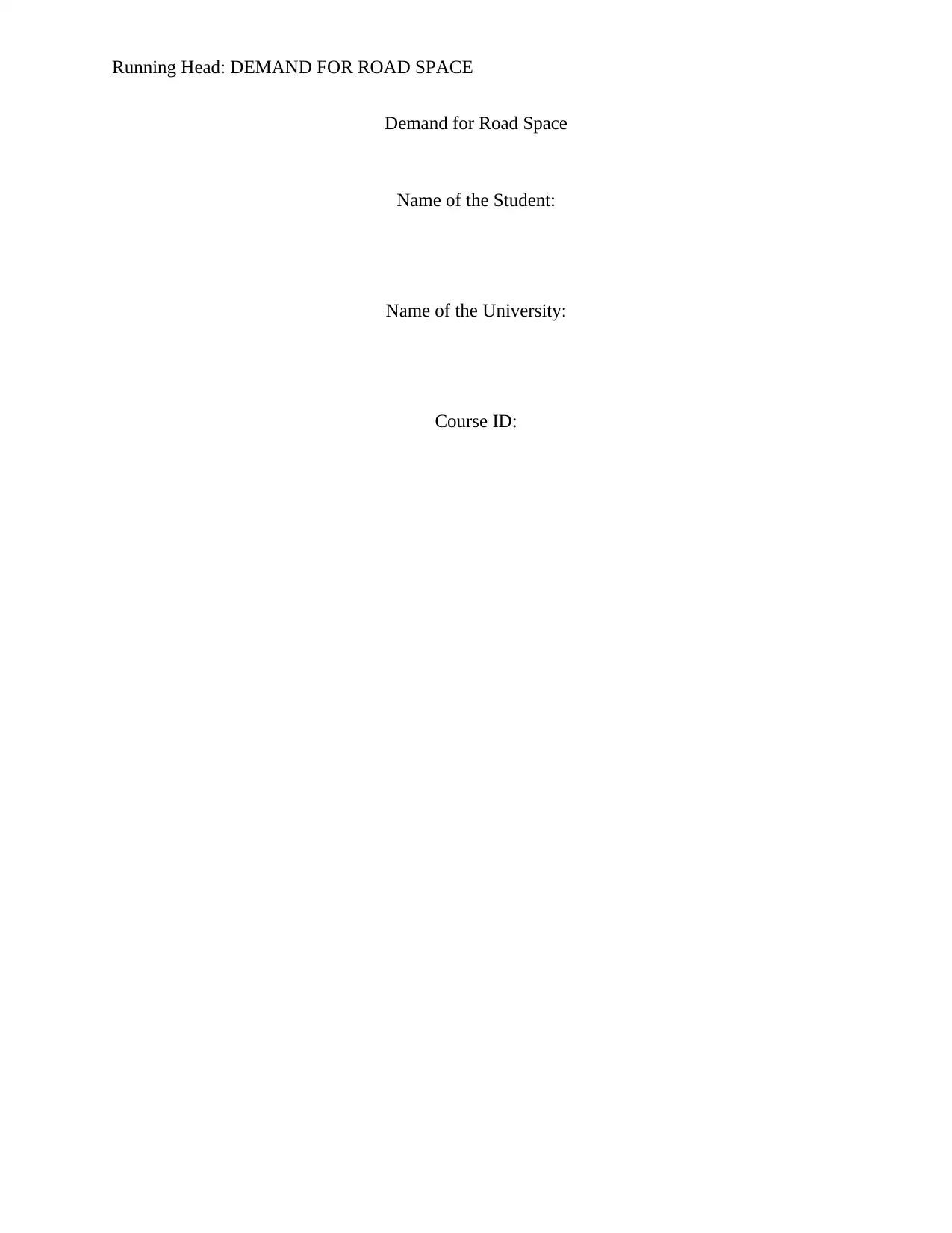
Running Head: DEMAND FOR ROAD SPACE
Demand for Road Space
Name of the Student:
Name of the University:
Course ID:
Demand for Road Space
Name of the Student:
Name of the University:
Course ID:
Paraphrase This Document
Need a fresh take? Get an instant paraphrase of this document with our AI Paraphraser
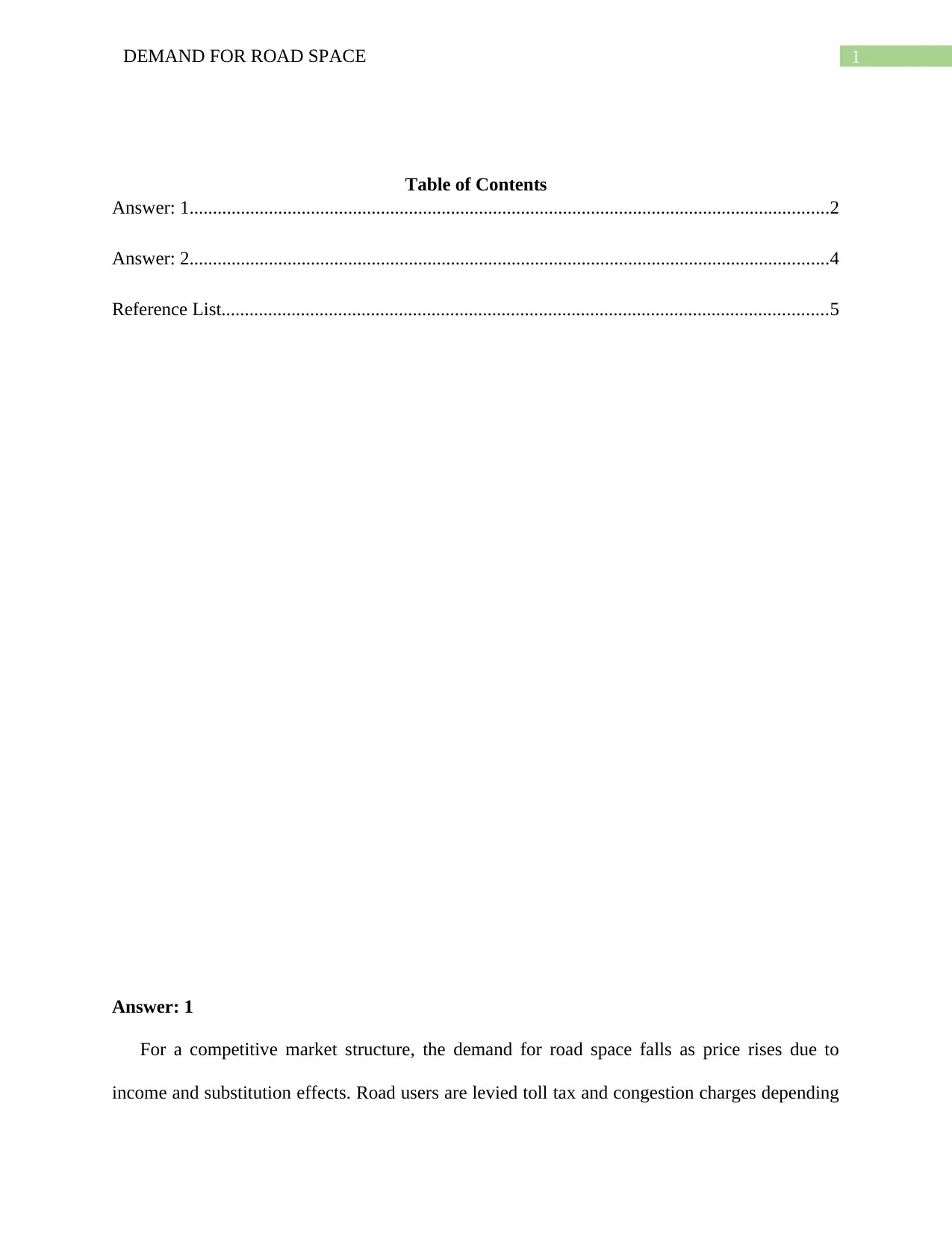
1DEMAND FOR ROAD SPACE
Table of Contents
Answer: 1.........................................................................................................................................2
Answer: 2.........................................................................................................................................4
Reference List..................................................................................................................................5
Answer: 1
For a competitive market structure, the demand for road space falls as price rises due to
income and substitution effects. Road users are levied toll tax and congestion charges depending
Table of Contents
Answer: 1.........................................................................................................................................2
Answer: 2.........................................................................................................................................4
Reference List..................................................................................................................................5
Answer: 1
For a competitive market structure, the demand for road space falls as price rises due to
income and substitution effects. Road users are levied toll tax and congestion charges depending
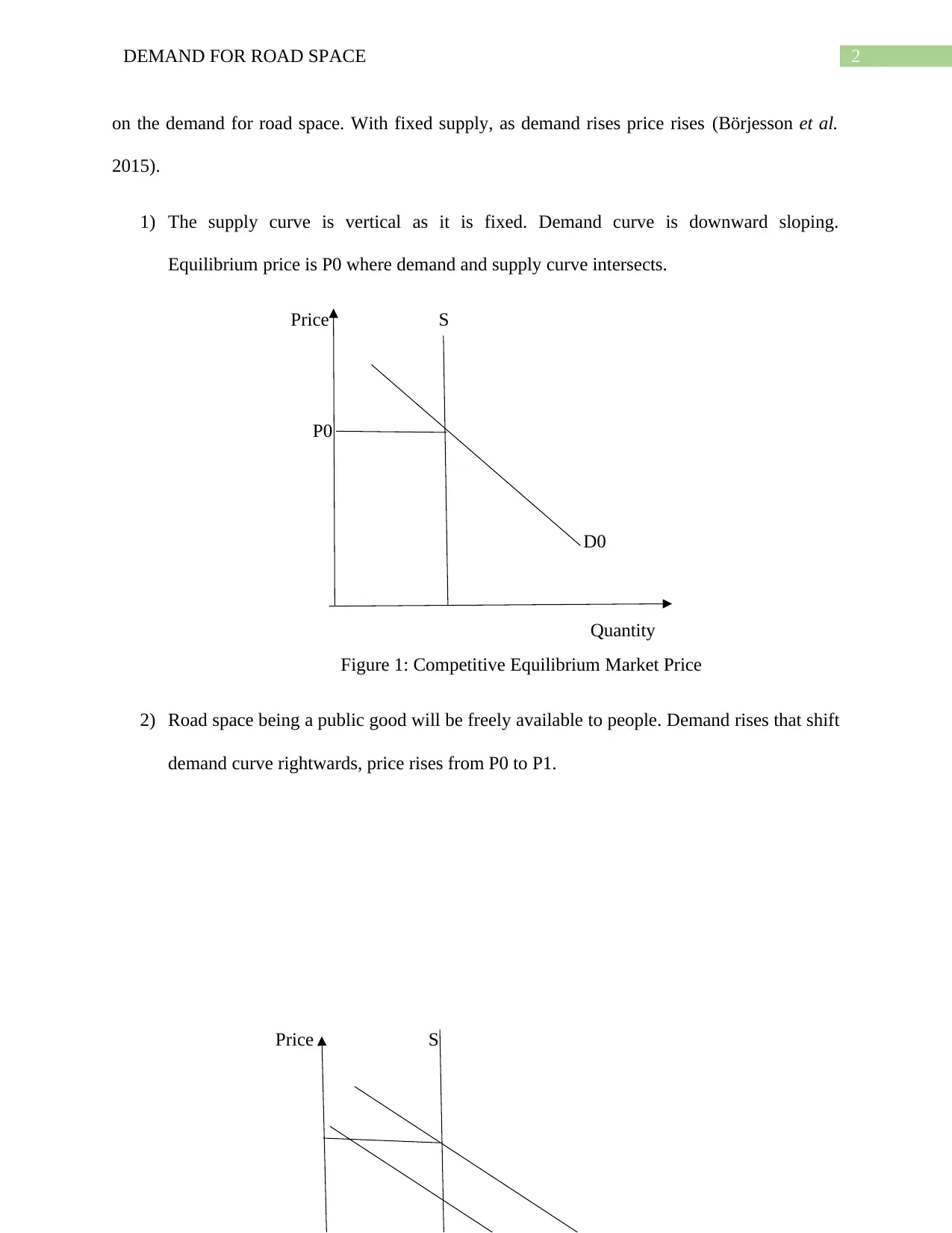
2DEMAND FOR ROAD SPACE
on the demand for road space. With fixed supply, as demand rises price rises (Börjesson et al.
2015).
1) The supply curve is vertical as it is fixed. Demand curve is downward sloping.
Equilibrium price is P0 where demand and supply curve intersects.
Price S
P0
D0
Quantity
Figure 1: Competitive Equilibrium Market Price
2) Road space being a public good will be freely available to people. Demand rises that shift
demand curve rightwards, price rises from P0 to P1.
Price S
on the demand for road space. With fixed supply, as demand rises price rises (Börjesson et al.
2015).
1) The supply curve is vertical as it is fixed. Demand curve is downward sloping.
Equilibrium price is P0 where demand and supply curve intersects.
Price S
P0
D0
Quantity
Figure 1: Competitive Equilibrium Market Price
2) Road space being a public good will be freely available to people. Demand rises that shift
demand curve rightwards, price rises from P0 to P1.
Price S
⊘ This is a preview!⊘
Do you want full access?
Subscribe today to unlock all pages.

Trusted by 1+ million students worldwide
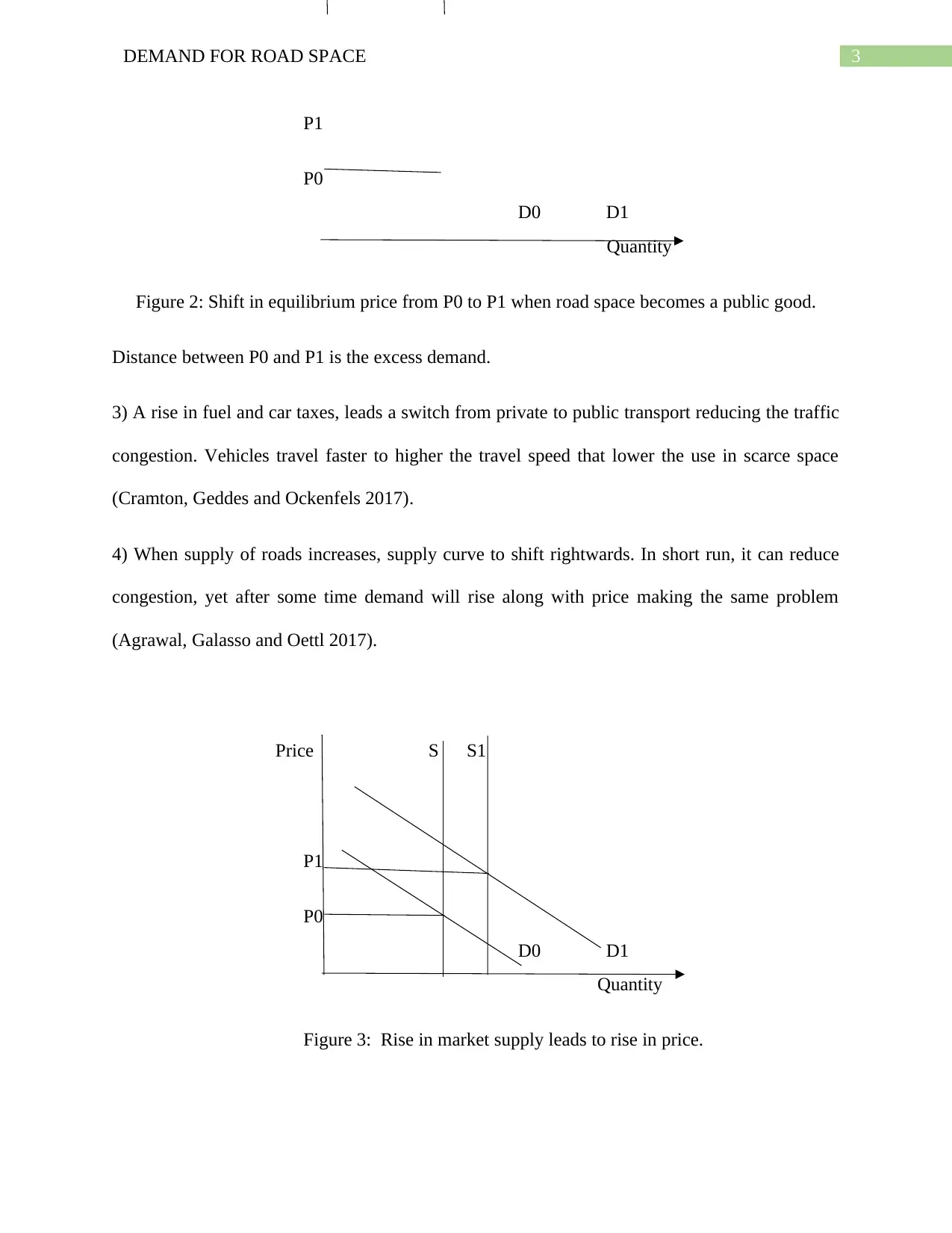
3DEMAND FOR ROAD SPACE
P1
P0
D0 D1
Quantity
Figure 2: Shift in equilibrium price from P0 to P1 when road space becomes a public good.
Distance between P0 and P1 is the excess demand.
3) A rise in fuel and car taxes, leads a switch from private to public transport reducing the traffic
congestion. Vehicles travel faster to higher the travel speed that lower the use in scarce space
(Cramton, Geddes and Ockenfels 2017).
4) When supply of roads increases, supply curve to shift rightwards. In short run, it can reduce
congestion, yet after some time demand will rise along with price making the same problem
(Agrawal, Galasso and Oettl 2017).
Price S S1
P1
P0
D0 D1
Quantity
Figure 3: Rise in market supply leads to rise in price.
P1
P0
D0 D1
Quantity
Figure 2: Shift in equilibrium price from P0 to P1 when road space becomes a public good.
Distance between P0 and P1 is the excess demand.
3) A rise in fuel and car taxes, leads a switch from private to public transport reducing the traffic
congestion. Vehicles travel faster to higher the travel speed that lower the use in scarce space
(Cramton, Geddes and Ockenfels 2017).
4) When supply of roads increases, supply curve to shift rightwards. In short run, it can reduce
congestion, yet after some time demand will rise along with price making the same problem
(Agrawal, Galasso and Oettl 2017).
Price S S1
P1
P0
D0 D1
Quantity
Figure 3: Rise in market supply leads to rise in price.
Paraphrase This Document
Need a fresh take? Get an instant paraphrase of this document with our AI Paraphraser
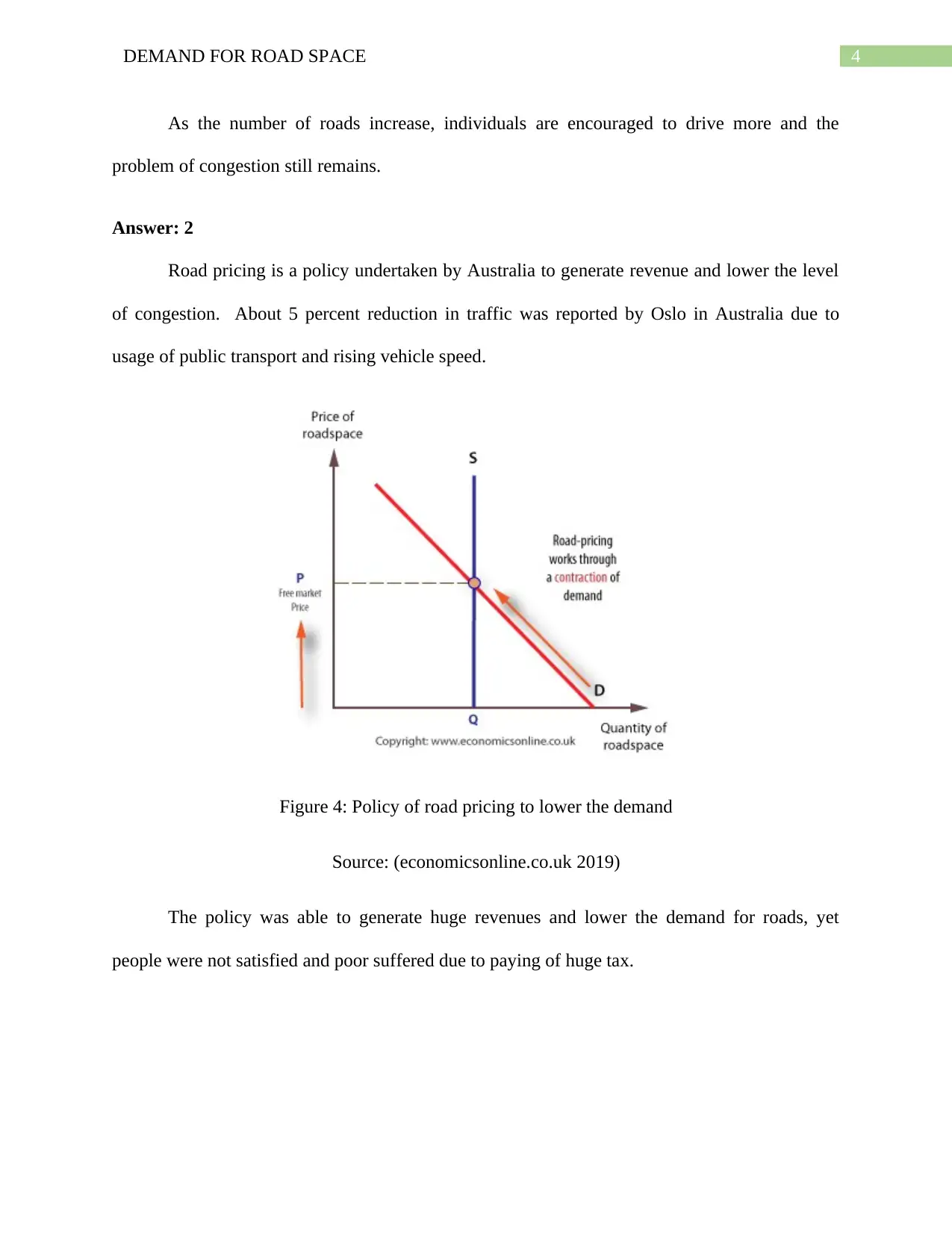
4DEMAND FOR ROAD SPACE
As the number of roads increase, individuals are encouraged to drive more and the
problem of congestion still remains.
Answer: 2
Road pricing is a policy undertaken by Australia to generate revenue and lower the level
of congestion. About 5 percent reduction in traffic was reported by Oslo in Australia due to
usage of public transport and rising vehicle speed.
Figure 4: Policy of road pricing to lower the demand
Source: (economicsonline.co.uk 2019)
The policy was able to generate huge revenues and lower the demand for roads, yet
people were not satisfied and poor suffered due to paying of huge tax.
As the number of roads increase, individuals are encouraged to drive more and the
problem of congestion still remains.
Answer: 2
Road pricing is a policy undertaken by Australia to generate revenue and lower the level
of congestion. About 5 percent reduction in traffic was reported by Oslo in Australia due to
usage of public transport and rising vehicle speed.
Figure 4: Policy of road pricing to lower the demand
Source: (economicsonline.co.uk 2019)
The policy was able to generate huge revenues and lower the demand for roads, yet
people were not satisfied and poor suffered due to paying of huge tax.
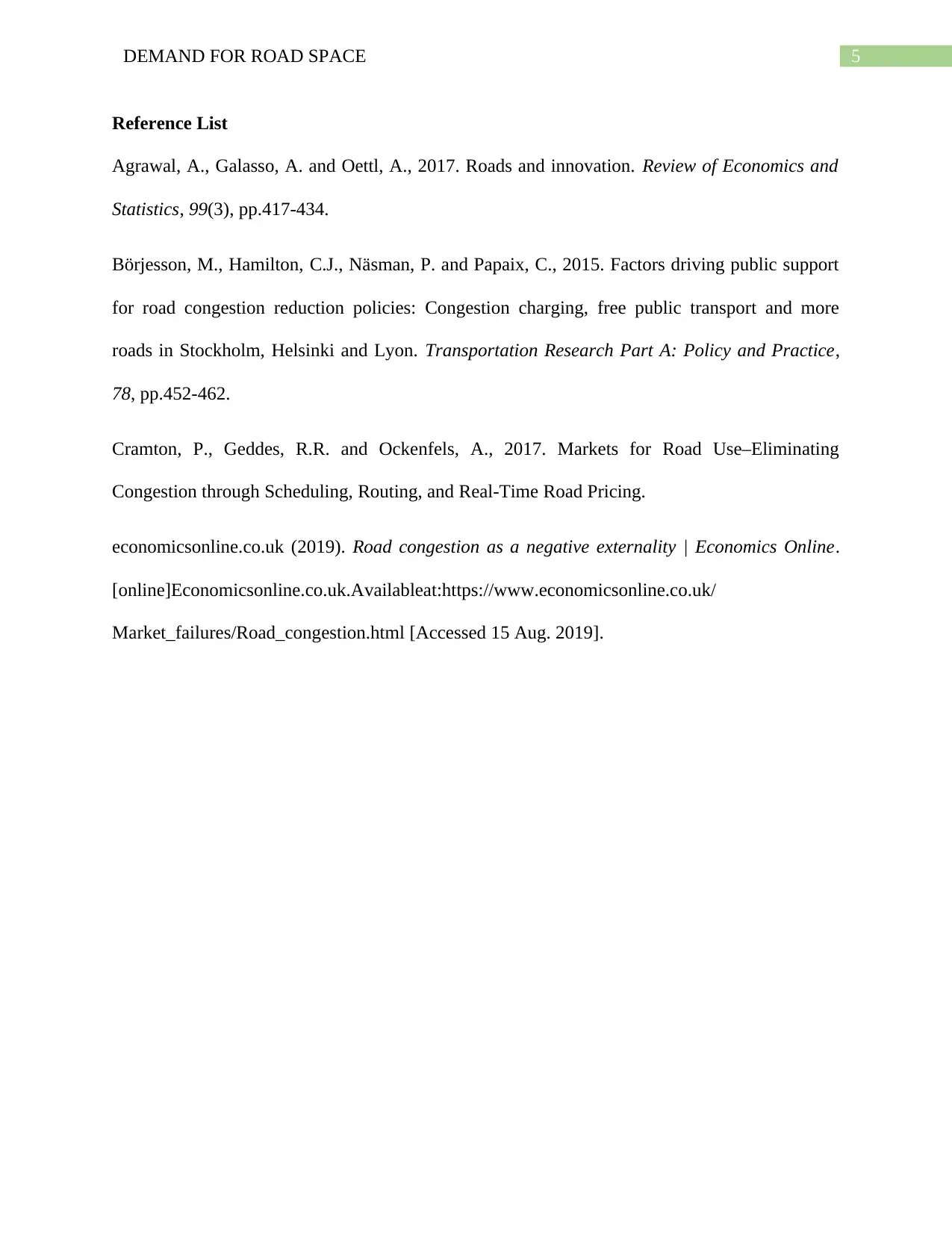
5DEMAND FOR ROAD SPACE
Reference List
Agrawal, A., Galasso, A. and Oettl, A., 2017. Roads and innovation. Review of Economics and
Statistics, 99(3), pp.417-434.
Börjesson, M., Hamilton, C.J., Näsman, P. and Papaix, C., 2015. Factors driving public support
for road congestion reduction policies: Congestion charging, free public transport and more
roads in Stockholm, Helsinki and Lyon. Transportation Research Part A: Policy and Practice,
78, pp.452-462.
Cramton, P., Geddes, R.R. and Ockenfels, A., 2017. Markets for Road Use–Eliminating
Congestion through Scheduling, Routing, and Real-Time Road Pricing.
economicsonline.co.uk (2019). Road congestion as a negative externality | Economics Online.
[online]Economicsonline.co.uk.Availableat:https://www.economicsonline.co.uk/
Market_failures/Road_congestion.html [Accessed 15 Aug. 2019].
Reference List
Agrawal, A., Galasso, A. and Oettl, A., 2017. Roads and innovation. Review of Economics and
Statistics, 99(3), pp.417-434.
Börjesson, M., Hamilton, C.J., Näsman, P. and Papaix, C., 2015. Factors driving public support
for road congestion reduction policies: Congestion charging, free public transport and more
roads in Stockholm, Helsinki and Lyon. Transportation Research Part A: Policy and Practice,
78, pp.452-462.
Cramton, P., Geddes, R.R. and Ockenfels, A., 2017. Markets for Road Use–Eliminating
Congestion through Scheduling, Routing, and Real-Time Road Pricing.
economicsonline.co.uk (2019). Road congestion as a negative externality | Economics Online.
[online]Economicsonline.co.uk.Availableat:https://www.economicsonline.co.uk/
Market_failures/Road_congestion.html [Accessed 15 Aug. 2019].
⊘ This is a preview!⊘
Do you want full access?
Subscribe today to unlock all pages.

Trusted by 1+ million students worldwide
1 out of 6
Related Documents
Your All-in-One AI-Powered Toolkit for Academic Success.
+13062052269
info@desklib.com
Available 24*7 on WhatsApp / Email
![[object Object]](/_next/static/media/star-bottom.7253800d.svg)
Unlock your academic potential
Copyright © 2020–2025 A2Z Services. All Rights Reserved. Developed and managed by ZUCOL.




